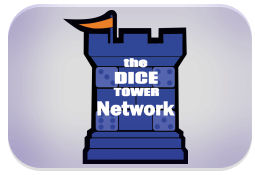Designer: Masato Uesugi
Artist: Paul Mafayon
Publiusher: IELLO
Players: 2-4
Length: Less Than 30 Minutes
Game Mechanics: Bluffing, Deduction, Push Your Luck
If it already weren’t taken “Outwit, Outplay, Outlast” would be a great tagline for Welcome to the Dungeon. Your goal is to survive the dungeon twice, or cause all your competitors to fail two dungeon adventures.
Originally designed by Masato Uesugi and published by Oink Games under the name of Dungeon of Mandom, IELLO has kept the core of the game, but added new art, additional adventurers, and redesigned some of the components with the help of artist Paul Mafayon.
It begins with a player choosing one of the characters and their gear tiles. Players can choose between a Warrior, Barbarian, Mage or Rogue. Each one has 6 pieces of equipment that will help them defeat the lurkers within!
 What evil lurks in this dark demesne, you may ask? A gaggle of greenskins? A scree of rock golems? A procession of undead? Yes to all, and more, but fear not. Every adventurer starts with enough gear to tackle each danger you might encounter, but herein lies the rub. In turn, each player will draw a monster card and either add it to the dungeon or discard it. If they choose to discard the card, they must also discard a piece of the adventurer’s equipment. Eventually it becomes a game of chicken. As people get nervous about their chances of survival, they will pass and will no longer participate in the round. When all but one of the players has passed, that remaining player takes control of the adventurer, and uses whatever equipment they have left to try to defeat the monsters that were placed in the dungeon.
What evil lurks in this dark demesne, you may ask? A gaggle of greenskins? A scree of rock golems? A procession of undead? Yes to all, and more, but fear not. Every adventurer starts with enough gear to tackle each danger you might encounter, but herein lies the rub. In turn, each player will draw a monster card and either add it to the dungeon or discard it. If they choose to discard the card, they must also discard a piece of the adventurer’s equipment. Eventually it becomes a game of chicken. As people get nervous about their chances of survival, they will pass and will no longer participate in the round. When all but one of the players has passed, that remaining player takes control of the adventurer, and uses whatever equipment they have left to try to defeat the monsters that were placed in the dungeon.
Each monster has a number that represents the strength of their attack. One by one you will reveal the monster cards that were choosen for the dungeon. You will compare them to the remaining equipment to see if you are able to defeat that type of monster. For example you may have the Holy Grail and if any undead creatures show up, they instantly will be destroyed by it. Or you may carry plate armor which adds 5 hit points to your adventurer and helps resist the damage of a monster that isn’t already defeated by some other piece of equipment. The damage dealt is equal to the number on the card. If you have managed to weather all of the monster attacks and still have hit points available, you have succeeded and gain a Success Card. If not, you will flip over your player aid to the red colored side to represent your first failure. If you fail again you are eliminated from the game. The game ends when one player has succeeded twice or until there is one player who hasn’t failed twice.
Game Play
The main mechanics of Welcome to the Dungeon are bluffing, deduction and push your luck. There’s no real innovation in how they are used. Players will pick up the monster cards and try to communicate its terribleness or lack there of through physical gestures and whether they put the monster in the dungeon pile or discarded it with their choice of equipment. The other players need to try to deduce what is happening based on those same clues being given out. Taking into account what you know and what you think your opponent is doing, you want try to stay in as long you can in order to influence the round and the other players. Maybe you know you discarded a few high damage monsters, so your goal is to push people out and take on the role of the adventurer. Or maybe you’ve added a few high damage monsters, and you want to escape before being the last person to pass. While the game play and decisions are simple, it can be really fun trying suss out information from your opponents. You don’t have to play a social game, but I find it definitely adds to the overall experience.
Component Quality
 In general the Japanese artistic temperament has a rather direct and simple aesthetic, which I like. In Dungeon of Mandom, the adventurer equipment is presented in a fairly bleak and lackluster way. The monster art on the other hand is quite good, and it’s almost jarring to look at the equipment and monsters side by side. IELLO has done an amazing job in it’s reimplementation. I really enjoyed the art done for the game by Paul Mafayon. He has created a very stylized “all ages” versions of iconic fantasy creatures. I was so impressed that I went looking for his other work, it turns out he did art for Looney Quest, Earth Reborn, and Seasons: Path of Destiny, which all look great. I hope to see more of it in games in the future.
In general the Japanese artistic temperament has a rather direct and simple aesthetic, which I like. In Dungeon of Mandom, the adventurer equipment is presented in a fairly bleak and lackluster way. The monster art on the other hand is quite good, and it’s almost jarring to look at the equipment and monsters side by side. IELLO has done an amazing job in it’s reimplementation. I really enjoyed the art done for the game by Paul Mafayon. He has created a very stylized “all ages” versions of iconic fantasy creatures. I was so impressed that I went looking for his other work, it turns out he did art for Looney Quest, Earth Reborn, and Seasons: Path of Destiny, which all look great. I hope to see more of it in games in the future.
Not only is the art impressive, but the adventurers and their equipment are welcome additions to this version. In the original, there was only a single character with a standard set of gear with which to go dungeon delving. Now with multiple classes and different sets of equipment, there are varied strategies for surviving and increasing the replayability.
What the game does well…
I really think the art adds a great deal to the gameplay. I can see myself being in the dungeon fighting off these creatures as they get flipped over. If I am not the adventurer, I can imagine myself as one of the dark overlords trying to trap and destroy anyone with enough curiosity or greed to venture forth. In spite of being a filler game, I find myself telling stories with Welcome to the Dungeon, which I really enjoy. I also think the use of a good quality card stock and the card board pieces elevate the experience. It just feels good to the touch.
Another thing I like is the risk assessment aspect of the game. I have a fondness for the simple rules of Welcome to the Dungeon. It can lead to some fun and occasionally difficult decision making. I like trying to read my opponent and deciding if they are adding to the dungeon so they can survive it or are trying to lure me in there to my doom. For me risk assessment is probably one of those mechanics that make a good game great, and I think it’s done well here.
What the game doesn’t do well…
The game play suffers more at higher player counts, since the game tends to lag somewhat with too many people having to make decisions. Also the amount of information available and the ability to deduce what’s going on becomes more difficult. When it comes to player elimination, I think the fewer the better. I think 2 is fast and enjoyable, but 3 might be optimal in order to see some of the depth of the game.
Overall Rating
I think this is a great filler game that can be brought out on occasion for a change of pace or a time killer while waiting for other games to finish. The theme is appealing, and the rules are easy to explain. There are interesting decisions to be made and fun player interaction when trying to gain more information.
Typically, I give lower ratings to these types of games, but within the filler niche I would easily give this one a 5. If you like bluffing/deduction/push your luck games check this one out. It easy to play and accessible to gamers of almost any skill level.
Matthew
The Dukes of Dice Rating System
1 = Poorly designed but playable. Not necessarily fun.
2 = Game has some merit, but has significant detractors.
3 = Game is okay, not exciting. Will play in the right situation.
4 = A good game. Worth playing, just not all the time. Belongs in the Duchy.
5 = A great game, will rarely turn down a play of it.
6 = An all-time favorite that is a contender for the top 10









